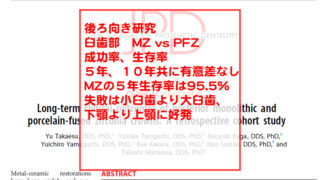水酸化カルシウム長期使用は歯根破折のリスクにはならない

前回の論文に対する反対論文が
前回は根未完成歯に水酸化カルシウムを長期貼薬すると歯根破折のリスクが高まるのではないかという論文を読みました。羊の歯を抜歯して破折強度を測定していました。
前回の論文は2002年でしたが、今回はそれから16年後の論文です。実は共著者にこの前の論文の筆頭著者の奥さんがいるみたいです。
The Effect of Long-term Dressing with Calcium Hydroxide on the Fracture Susceptibility of Teeth
J Endod. 2018 Mar;44(3):464-469. doi: 10.1016/j.joen.2017.09.018. Epub 2017 Dec 16.
https://www.ncbi.nlm.nih.gov/pubmed/29254817
PMID:29254817

Abstract
Introduction: Calcium hydroxide has been widely used to treat immature teeth to achieve periodontal healing and to promote the formation of an apical barrier. However, retrospective clinical studies have shown a high incidence of cervical root fractures with long-term calcium hydroxide dressing. The alkalinity of calcium hydroxide has been suggested to weaken the root. In vitro studies using ovine teeth show conflicting results on fracture strength of dentine, although different commercial products may have influenced the results. The purpose of this study was to investigate the effects of 2 commercial products used in prior studies (Calasept Plus and UltraCal XS), as well as a new product (Calmix) that uses a nonaqueous vehicle that allows for a higher pH, on the fracture strength of dentine over time.
Methods: A total of 330 lamb incisor teeth were collected and the canals prepared so that 3 commercial calcium hydroxide products as well as a positive control of pure calcium hydroxide slurry that filled the root canalfrom the open apex and a negative control of saline was tested. The teeth were loaded until fracture with a universal testing machine at time points 0, 3, 6, and 9 months and the force to fracture was calculated. The data were analyzed with Friedman analysis of variance and Mann-Whitney t tests. Results: No statistical differences were observed between the different calcium hydroxide products and the negative controls.
Conclusions: Thin and fragile roots could be the cause of fracture rather than the calcium hydroxide dressing.
緒言:水酸化カルシウムは根未完成歯の根尖部の形成促進や周囲組織の治癒を目的として広く用いられています。しかしながら、後ろ向きの臨床研究では、長期間の水酸化カルシウムの貼薬は歯頸部での歯根破折を起こすリスクが高くなると報告されています。水酸化カルシウムがアルカリ性であることが歯根を脆弱化することが示唆されてきました。羊属の歯を使用したin vitroの研究は相反する結果を示しており、商品差が結果に影響している可能性があります。
今回の研究の目的は、以前の研究で使用された2つの商品(Calasept PlusとUltraCal XS)と高pHとなる非水溶性媒体を使用している新しい商品(Calmix)が破折強度に与える影響を調べることです。
実験方法:330本の子羊の切歯を用いました。3つの商品+ポジティブコントロールとして水酸化カルシウムを練和したもの+ネガティブコントロールとして生理食塩水を開大した根尖部から充填しました。0、3、6、9か月後に試験機を用いて破折強度を測定しました。
結果:各水酸化カルシウムとネガティブコントロールである生理食塩水間において破折強度に有意差を認めませんでした。
結論:水酸化カルシウム長期貼薬の影響よりも歯根の厚みと弱さが破折の原因ではないかと考えられました。
ここからはいつものように適当に抽出して意訳しますので、気になった方は原文をご確認いただきますようお願いいたします。
緒言
緒言ですが、ここが重要なところなのでほぼ全部訳しています。
以下の2つの後ろ向き臨床研究が根未完成歯に水酸化カルシウムを長期貼薬すると歯頸部での歯根破折のリスクが高くなると報告しています。その割合は40%と32%となっています。
Cvek M. Prognosis of luxated non-vital maxillary incisors treated with calcium hydroxide and filled with gutta-percha. A retrospective study. Endod Dent Traumatol 1992;8:45–55.
Al-Jundi SH. Type of treatment, prognosis, and estimation of time spent to manage dental trauma in late presentation cases at a dental teaching hospital: a longitudinal and retrospective study. Dent Traumatol 2004;20:1–5.
また羊の歯を使った実験では1年後に破折強度が半分になったという報告があります(これが前回読んだもの)。
多くのin vitroの研究も水酸化カルシウムにより歯質が脆弱化するという説を支持しています。人の切歯では水酸化カルシウムを7~84日貼薬すると23.0%~43.9%微少引っ張り破折強度が低下するという報告もあります。他にもヒトの歯をつかった報告は複数あり(実際文章では紹介されていますがここでは略します)、水酸化カルシウムを長期貼薬する方法は推奨されずMTAを代わりに使用するように言われています。
最近の羊の歯を用いた研究では3つの異なる水酸化カルシウムを6か月貼薬しました。生理食塩水を充填した群と比較すると有意差は認められませんでした。特に生理食塩水を充填した群が最も破折しやすい結果となりました。同様に、他の羊群を用いた研究でも水酸化カルシウム12か月貼薬と比較して生理食塩水充填群が最も破折しやすい結果となりました。これらの結果はCalaseptという水酸化カルシウムを用いたAndreasenらの結果と異なります。Andreasenらの研究では生理食塩水のコントール群は2か月以上実験されず、これ以上期間が経つと破折しやすくなるのかどうかが検討されていません。Hawkinsらは水酸化カルシウムの成分の違いが結果の違いに関係しているのではないかと仮定しています。水酸化カルシウムに異なる媒体を使用すると、Caイオンが象牙質に拡散する割合に影響を与えると思われます。
Calaseptは41.07%水酸化カルシウム+等張食塩水でpHは12.4です。UltraCal XSは35%水酸化カルシウム+不溶性媒体でpHは12.5です。純粋な水酸化カルシウムはpH12.5~12.8です。水酸化カルシウムを溶解する許容範囲以上入れてもそれ以上は溶解せずpHも上昇しません。しかし、溶解しなかった座利用は水酸化カルシウムペーストを厚くし、今後のヒドロキシイオンの放出を可能とする予備軍として働くでしょう。水酸化カルシムのpHは非常に重要です。それは象牙質の酸性蛋白やプロテオグリカンなどを中和、変性させて象牙質を脆弱化する事が示唆されているからです。そのため、新しい水酸化カルシウムの商品が発売されました。Calmixという材料でポリエチレングリコールを媒体として使用しています。これにより従来の材料よりもpHが高く、ヒドロキシイオンが多く放出されます。加えて、ポリエチレングリコールを使用した場合、ヒドロキシイオンが象牙細管を通過する量がかなり多くなります。calmixは37.5%水酸化カルシウム+45.5%ポリエチレングリコールで、pHはメーカーは13.5以上と公表していますが、15.16まで到達します。
過去の研究では純粋な水酸化カルシウムに関しては検討されていません。また、他の研究ではサンプルサイズが少ないという問題があります。今回の研究ではそれらを解消する実験系が組まれています。
実験方法
過去の実験を元に実験計画を立てています。

9か月の子羊から屠殺直後に下顎切歯を330本抜歯しています。抜歯後すぐに組織固定用の10%ホルマリン溶液中に室温で保管されました。目視でクラックがないかを確認しています。1週間後にCEJから10mm根尖側の部位でダイヤモンドバーで歯根をカットしました。残っている歯髄をブローチで除去しました。歯根先端から#30 04テーパーのファイルで根管を形成しました。5mlの次亜塩素酸ナトリウム→5mlのEDTA→5ml生理食塩水でフラッシュしペーパーポイントで乾燥しました。
330本の歯は以下の様に割り振られました。


所定のものを充填後に根尖部は水硬性セメントであるCavitで封されています。その後37度の生理食塩水中に保管され、1週間に1回生食は交換されています。
所定の時期が経過後に歯根を石膏で包埋して試験機で測定する形になります。図に示すように包埋した部分をつかんで歯頸部で破折するように設定しています。

結果
結果として水酸化カルシウム貼薬は9か月経過後においても破折強さを低下させませんでした。Calasept Plus,、UltraCal XS、 Calmixの破折強さの低下はそれぞれ7.59、1.79、4.35MPaでした。またポジティブコントロール、ネガティブコントロールの破折強さの低下はそれぞれ6.87、4.66MPaでした。全ての群で破折強さの低下に有意差は認められませんでした。9か月後の破折強さに関しても全群間で有意差を認めませんでした。


考察
今回の有意差なしをサポートする論文としては以下の2つがあります。
Hawkins JJ, Torabinejad M, Li Y, et al. Effect of three calcium hydroxide formulations on fracture resistance of dentin over time. Dent Traumatol 2015;31:380–4.
Hatibovic-Kofman S, Raimundo L, Zheng L, et al. Fracture resistance and histological findings of immature teeth treated with mineral trioxide aggregate. Dent Traumatol 2008;24:272–6.
Andreasenらの研究などの水酸化カルシウムが象牙質を脆弱化するという結果と異なる理由については以下の様な考察がされています。
The differences in these conflicting results may be explained by the lack of comparable control time frames and the small number of teeth tested, where a substantial standard deviation between specimens was noted. Another difference between the studies was the choice of the indenter that applied the load to the tooth. The current study used a broad 6-mm diameter (Fig. 1) that covered most of the tooth and may more accurately affect the area of a force from a blow to the tooth. Prior studies used a spade (8, 14, 18) or blade (17) in which the force to fracture was applied only to a specific point either 2.5 mm from the incisal edge of the tooth (8, 14, 18) or 1 mm coronal from the CEJ
Andreasenらの研究ではコントロールは2か月しか保存せずに破折試験をしています。そういったコントロールも時系列を揃えることをしていなかった、ということと、試験試料の数の少なさを大きな理由として挙げています。
また、破折試験に使うシリンダー部の大きさの選択も挙げています。今回の実験では直径6mmを使用しています。これだと歯面全部をしっかり押すことができます。以前の研究では鋤や刃などの一点に集中するようなものが使われていました。

臨床研究で外傷歯に対する水酸化カルシウムの長期使用は歯頸部の破折を増加させるという報告がありますが、それとの整合性をつけるために以下の様な考察がされています。
The suggestion that long-term dressing with calcium hydroxide weakens tooth roots arises from 2 retrospective clinical studies that reported a 40% and 32% incidence of fracture, respectively, in traumatized teeth (6, 7). In the article by Cvek (6), there was a significant association between the stage of root development and cervical root fracture. The incidence of fracture for 26 teeth with less than half of final root development was 77%. Continued root development is significant, as 194 teeth with a wide-open foramen and nearly completed root development had a 27% lower incidence of fracture. The incidence of fracture was also significantly associated with defects in the root after healing of inflammatory root resorption (P < .0001). This data would suggest that factors relating to the stage of root development rather than the calcium hydroxide placed in the root canal may be responsible for the higher incidence of cervical root fracture. To further confirm that the incidence of root fracture is related to root development, the incidence of cervical root fracture in the 362 teeth in which root development was completed with a closed apical foramen was only 2%. This may be an important consideration, as this group of teeth had a mean dressing time with calcium hydroxide for 11 months without the high incidence of fracture
破折リスクは歯根の完成度と関係しており、歯根がほぼ完成している場合は水酸化カルシウムの長期使用に関係なく破折リスクはかなり低くなっています。そのため歯根の厚みなどの方が水酸化カルシウムの使用よりも歯頸部での破折に影響するという考察になっています。また外傷が破折のリスクになり得るという考察がこの次に来ます。ここでsecondary traumaというのが出てくるんですが、外傷歯の話でsecondary traumaとは何かがちょっとよくわからず・・・・。2回目やっちゃったって事でしょうか?
勿論この論文にも限界があります。羊の歯を抜歯して使っていますし、根未完成歯の質を一定化するために根を切断したりしています。
まとめ
実験系をもっと厳密にしたら有意差は無かったということです。確かに2002年のAndreasenの論文はコントロールが2か月で打ち切られたりと実験系に問題があったと思われます。
かなりpHが高く象牙質への浸透性が期待できる水酸化カルシウムCalmixを使用しても破折強度にはコントロールとも他の水酸化カルシウム製剤とも有意差がなかったとと言う結果でしたが、in vitroでは水酸化カルシウムのアルカリ性が象牙質に与える影響が示唆されています。
これを統合すると確かに水酸化カルシウムは象牙質の構造を脆弱化するが、それを長期使用したとしても根未完成歯の破折の主誘因になる程ではない、という結論になるのではないかと思います。
根がまだかなり未完成で歯髄壊死した場合の破折リスクというのはやはり物理的に充分あり得るという事を患者と保護者に伝えておく必要がある、というのは間違いない所でしょう。








